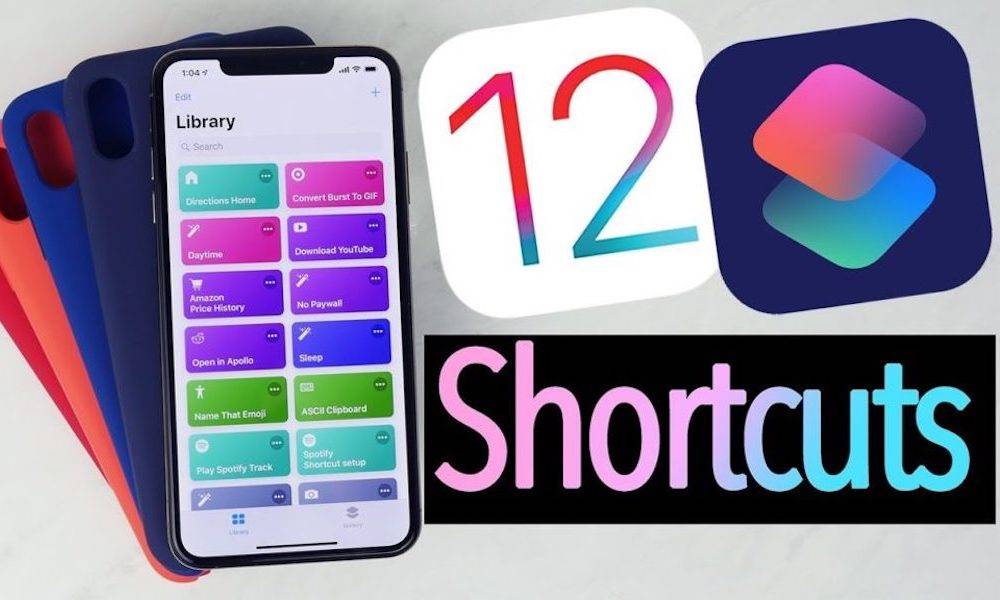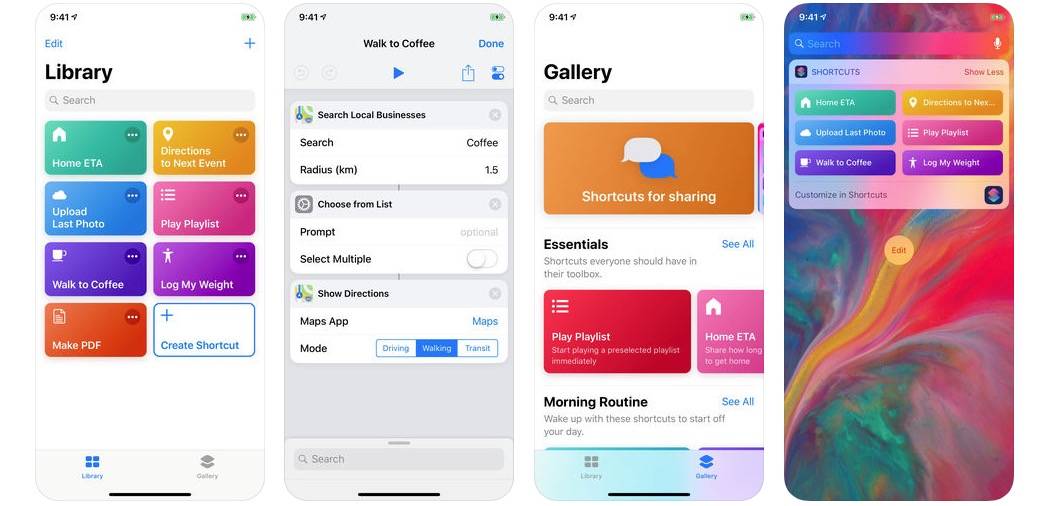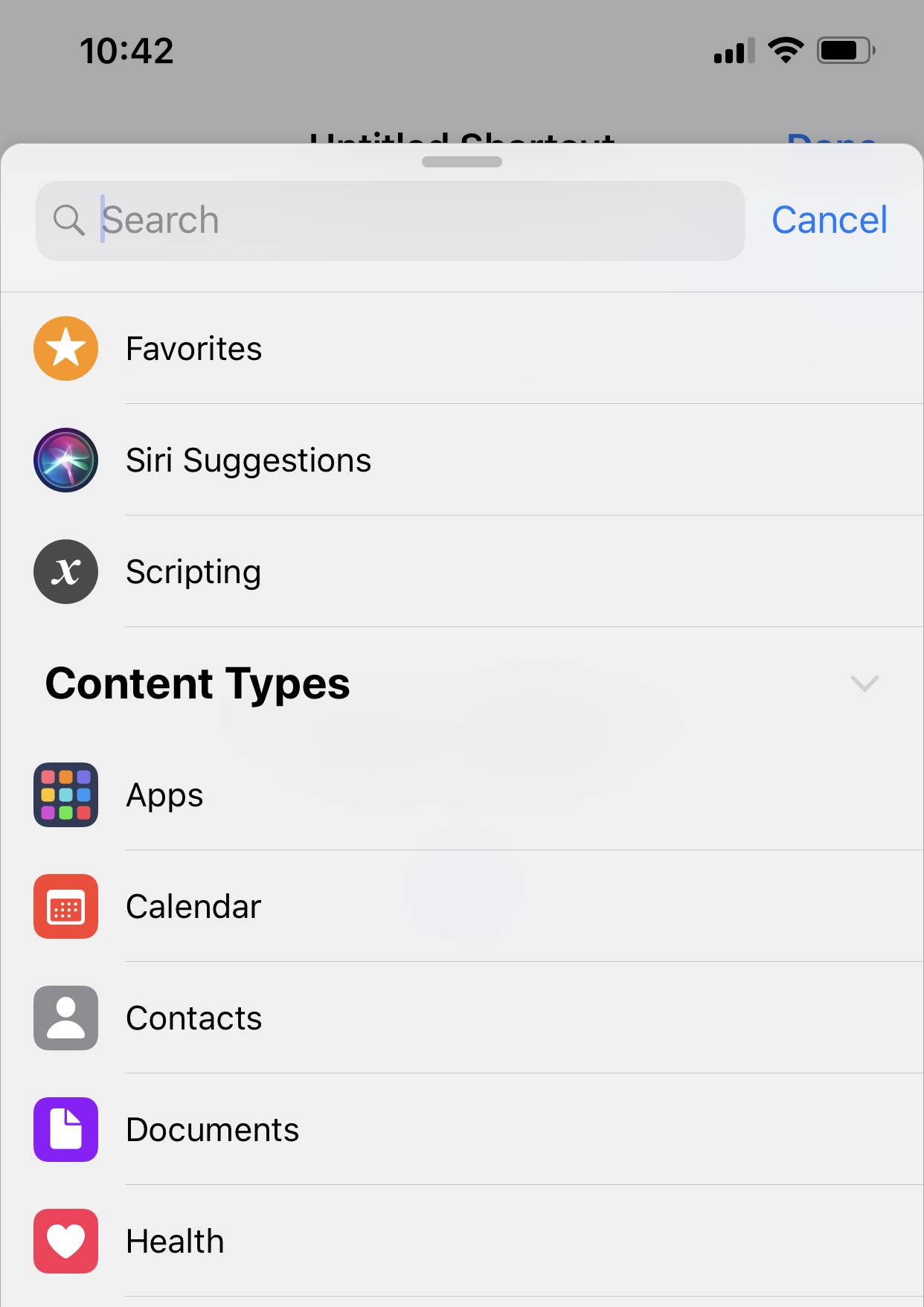Everything You Need to Know About the New Shortcuts App in iOS 12
 Credit: iPhone Hacks
Credit: iPhone Hacks
Toggle Dark Mode
iOS 12 includes many new features such as new Animoji and Memoji, improved Do Not Disturb, upgrades to augmented reality, and more. Alongside iOS 12, Apple updated its Workflow app and renamed it “Shortcuts.” It’s a fantastic automation app that all iPhone owners can benefit from using. But first, here’s some background information.
? RIP Workflow
Workflow was acquired by Apple in the spring of last year. The popular app is similar to IFTTT and allows users to create scripts that carry out a string of tasks. Workflow was somewhat limited in the sense that it didn’t have access to core iOS features such as iMessage and HealthKit. But now, with Shortcuts, Apple is looking to change that.
Shortcuts has access to many iOS functions and even allows developers to add support for their third-party apps. Additionally, it adds support for Siri, allowing users to create their own unique voice commands to execute their shortcuts.
? What Does Shortcuts Do?
If you’re familiar with scripts, programming, or macros, you probably understand the basics of the new Shortcuts app. You may have even had Workflow installed prior to the update. But, if you’ve never used an app like this you might be feeling a bit confused, lost, or overwhelmed.
Essentially, the app aims to help you accomplish multiple tasks — called shortcuts — with one tap or voice command.
This means you can say something like “Good morning!” And your phone will automatically prepare your morning routine. You can have your lights turn on, your coffee made, and your route to your first appointment mapped all with that one phrase.

So Shortcuts makes it easy to string multiple steps — called actions — together, but it also does so much more. With all of the actions available you could potentially do just about anything. For example: The Web-scripting actions might make accessing a certain website faster. The messaging and contacts scripts can let you send a text to your boss or team members letting them know you’re late with one tap. And creating a voice command for logging your weight or water intake has never been so easy.
The possibilities are seemingly endless. Or… are they?
? Shortcuts Limitations
There are still quite a few limitations. If you have a smart home, the Home app only allows you to control scenes. While this might be great for adding multiple ways to set a scene, it doesn’t allow users to add additional commands to individual accessories. There are also some settings that can’t be altered, but some of them make sense for security purposes. Voice commands announce they’re running a shortcut, which just seems odd. And scripts requiring input open the shortcut within the Shortcuts app, rather then having a pop up or window of their own. This creates more taps in some cases and can defeat the point of shortcuts.
Additionally, some shortcuts just seem odd. For example, Siri can handle many shortcuts using already existing commands — some of which are faster. Also, the suggested Shortcuts often aren’t things we would use.
A strange thing about Shortcuts is that it undermines the very point of Siri.
Since Siri uses natural language processing it shouldn’t require specific voice commands. Similarly, Siri should understand alternatives to the voice commands that we do decide to add; but it can’t.
For years, we keep being told that Siri is contextual and that machine learning is becoming more advanced. But its inability to string multiple requests and perform some basic commands can be confusing; especially now, when it’s been with us so long.
While Shortcuts is great in its own way, Apple could probably deliver a much better user experience by focusing on making Siri smarter, more versatile, and more adaptable. But for now Shortcuts is a fantastic app that will hopefully lead to even more great features moving forward.
1 How Do I Find the Shortcuts App?
The Shortcuts app can be found on the App Store.
If you previously had the Workflow app it should have been automatically updated. If not, you can update it through the App Store.
Siri Shortcuts and shortcut suggestions can be found under the Siri settings of your iPhone or iPad.
2 How Do I Add Shortcuts?
You can add Shortcuts using the suggestions as described earlier, from the in-app Gallery, or by creating your own.
Each Shortcut consists of tasks called “actions.”
When you add a Shortcut you’ll see the “Shortcut Editor.”
The editor will be empty at first, but you can add actions, customize them, and move them around until you’re ready to save and use your Shortcut.
Suggested Shortcuts
- Open Settings and select “Siri & Search.” You should see a section for suggested Shortcuts.
- If you see one you want to add, just tap it and record a personalized phrase for Siri to recognize.
You can also find suggested Shortcuts in the app.
- Just tap “Create Shortcut” or select the “+” in the top right corner.
- Then tap the search bar and select Siri suggestions. This will add an action in the Shortcut Editor.
- You can add other actions and save the Shortcut when you’re done.
Library
When you open the Shortcuts app you’ll see your Shortcuts Library. Any Shortcuts you add will show up here. Tap a Shortcut—displayed as colored tiles—to run it.
Gallery
At the bottom of the Shortcuts app are tabs for Library and Gallery. Select the Gallery tab to browse dozens of pre-made Shortcuts.

Tap a Shortcut you want to learn more about. You can select “Show Actions” to see how the Shortcut works; or, tap “Get Shortcut” to add it to your Shortcuts Library. You can make changes to the Shortcut later if you want or run it the way it is.
3 How to Create Your Own Shortcuts
Sure you can use the gallery and suggestions to make Shortcuts, but you can also create your own. Just tap the “+” or the “Create Shortcut” tile to get started.
The Shortcuts Editor
You’ll be presented with a blank Shortcut in the Shortcuts Editor. The top-left corner of the menu bar shows undo and redo buttons.
The center has a run/play icon (for testing your completed Shortcut), and the top-right corner displays icons for the share sheet and Shortcuts settings.
To add an action, tap the Search bar at the bottom of the page.

You can scroll through categories and suggestions, use advanced scripting actions, select from favorite actions (when you’ve added them), or search for an action by typing text in the search bar.
The Building Blocks of Shortcuts
Dragging actions onto the page is similar to coding, only visual. Essentially you’re telling the Shortcut to run these steps—actions—in a specific order with certain parameters. So if you want Shortcut for your commute, you can do just that.
Let’s say you commute to work each day and like to know your ETA and route to avoid traffic, you stop by your favorite coffee shop on the way (which happens to support online ordering and Shortcuts), and you have a very specific playlist you listen to in order to wake you up and prepare you for the day. Why not simplify all of this with a Shortcut?
Get the Music Started
First, let’s get things rolling with your favorite playlist.
- Under the music category tap and hold the “Get Playlist” action and drag it into the edition.
- On the action block, specify the playlist you want to use. Now go back and drag the “Play Music” playlist directly under the “Get Playlist” action.

- If you want to shuffle or repeat the playlist, configure these options within the action. Otherwise just leave it.
- Good job! Now you have the first step completed. You can press the run/play button at the top of the editor to test what you have so far, or you can move on to the next step.
Coffee Time
Mornings are better with caffeine. Now that you’re music is playing, you need to get your coffee brewing.
If you have a HomeKit-supported coffee maker you can use a Home action to get things started.
Or, if you have a favorite coffeehouse with support for Shortcuts, you can have your order ready to go when you get there. Just add the action under your music and configure it as needed.
In Two Miles, Turn Right
On a long commute, sometimes it’s nice to see your ETA and the traffic on your route.
- Let’s use the “Street Address” action to specify your work address.
- Find it in the Actions menu, you can search for “maps” or “address.”
- Drag it onto the page below your previous actions.
- You’ll need to set the parameters for this action. Just tap and type. You might notice a bar with variables and suggestions. This will let you choose from a variety of variables to use with this action. For example, the “Ask When Run” variable will let you specify the input when the Shortcut is run.
- There is also a “magic variable” option that lets you choose an input from previous actions. For now, just enter the street address you’d like to use.
- To complete this Shortcut we need more than just the address. We need to get directions to the address. Find the “Show Directions” action and tap it or drag it on to the page. Choose the maps app you want to use and you’re good to go.
- Tap the run/play button to test your creation.
You’re Almost Done
Tap the settings icon in the top-right corner to name your Shortcut , choose an icon, and select some other options we’ll cover later. When you’re done, press “Done” to exit settings. Press “Done” again to close and save your new Shortcut.
4 Using Shortcuts
Shortcuts can be run from the app, by using the widget, or with voice commands. You might want to use different methods for different Shortcuts. For example, a Siri Shortcut can help you add multiple commands for controlling HomeKit scenes. The Shortcuts app can make it easy to browse all of your Shortcuts. And the widget can speed up some tasks with just a couple of taps.
Using Siri Shortcuts
You can record a voice command to run your shortcut. For new or existing Shortcuts, you can do this in the Shortcuts app. You can also rerecord the command within the Settings app.
- To record a new Siri command, open the Shortcuts app and tap the “…” on the Shortcut you want to edit.
- Now select the settings icon in the top-right corner of the editor.
- Tap “Add to Siri” and press the red button to record your phrase.
- When you’re finished recording, you can edit the recording or press “Done” to save.
- Now just say your phrase to Siri to run your Shortcut.
Using the Shortcuts App
The Shortcuts app is pretty straight forward. Launch the app and tap the Shortcut — or Shortcuts — you want to run. That’s it!
You can also rearrange your Shortcuts by tapping and holding a Shortcut tile.
Just move them around when they start to wiggle and tap “Done” when you have it the way you want it.
Widget, Home Screen Icons, and Share Sheet Actions
When editing a Shortcut, select the settings icon to find more ways to use your Shortcut.
In addition to Siri, you’ll see toggles for “Show in Widget,” “Show in Share Sheet,” and a button labeled “Add to Home Screen.”

There is even an option for sharing your Shortcut with a friend.
Turning on the option to show in widget does exactly what it says: it adds the Shortcut to the widget. If you’re unfamiliar with widgets, they’re found in the Today View by swiping to the far left on the Home screen or within Notification Center.
They can also be found by using 3D Touch on a corresponding app. The first four Shortcuts enabled for the widget will show up when the Shortcuts app is pressed hard, the others will show up when expanding the widget within the Today View.
The Share Sheet toggle lets you add the Shortcut to be used with the share icon in any app. You can also add a Web bookmark to the Home screen that will look like another app.
? Making Changes
In addition to rearranging Shortcuts — as mentioned earlier — you may want to make changes down the road. For example, maybe you have a different work address or want to change the playlist you use for your commute.
To edit a Shortcut, tap the circular eclipse (…) icon in the top-right corner of a Shortcuts tile.
Make any changes you want and save.
You can also delete and duplicate Shortcuts from the library. Just tap edit and select the Shortcut(s) you want to delete or copy, then use the corresponding icons in the top right.
? Recommended Shortcuts
There are tons of great ideas for Shortcuts and many can be found — and later edited — in the Shortcuts Gallery. Here are a few great Shortcuts to consider:
- Map out the next location on your calendar
- Log different health stats, such as water or weight
- Send a message to the members of your next meeting telling them your running behind
- Easily share your location over multiple platforms
- Schedule social media posts
- Find nearby gas stations
- Set specific timers
- Get directions to locations you don’t want to add to your address book
? And More
If you’re great at scripting — or even want to learn — try out some of the scripting actions in the Shortcuts editor. Who knows, maybe you can make Siri do something really awesome. Apple has a fantastic guide on their website for really getting to know Shortcuts inside-and-out on a much deeper level.
There really are so many cool things you can do with Shortcuts. This can’t be stressed enough. Sure, it has its limitations, but it brings users closer and closer to truly having a computer in their pocket. Here are just a few more things you can do.
Importing Questions
If you want to share your Shortcut, but don’t want to share personal details with the person you’re sending it to, you can choose to have the Shortcut “import questions” when it’s run.
- To do this, find and edit a Shortcut.
- Open the Shortcut’s settings and tap “Import Question.”
- Tap “Add New Question…” and select the fields you want to use.
- Once this is all setup, share your Shortcut and when the new user runs it, it will ask them for the details they want to use.
Shortcut Reminders, Search, and Third-Party Apps
Need to remember to run a Shortcut? Apple has you covered. Open the Shortcuts app and find a Shortcut. Open the editor (…). Say “remind me about this” (or something similar) and Siri will create an actionable reminder.
You can also search for a Shortcut from the Home screen. Just swipe down and type the name of a Shortcut. If enabled, Shortcuts can also be run from third-party apps using the Share Sheet. Third-party apps can also add support for Shortcuts. Here’s hoping car companies start supporting Shortcuts so I can tell Siri to start my car.
? What’s Next?
Shortcuts is one of the most exciting apps for iOS 12 because it opens up new possibilities for users. Now instead of relying on developers — or Apple — iOS users can start to accomplish tasks that were previously only available with third-party apps or firmware updates. And it can only get better from here.
Maybe we’ll see a Shortcuts app added to macOS (Apple could update Automater) or maybe will get contextual Siri commands. Hopefully Apple will add more actions to their own apps, like the ability to add individual accessories from the Home app.
Do you like Shortcuts? What Shortcuts have you created? What do you hope to see or accomplish down the road? Let us know in the comments section below and on social media. Thanks for reading!






